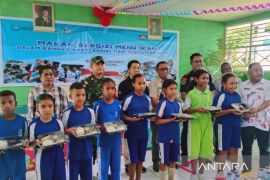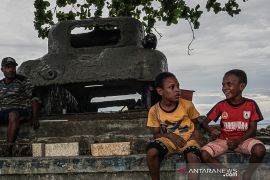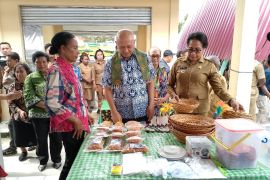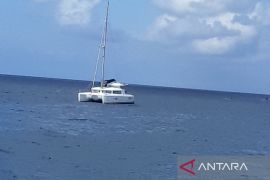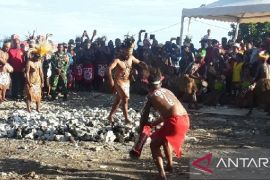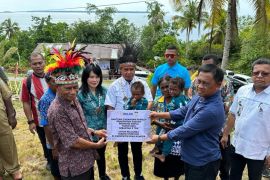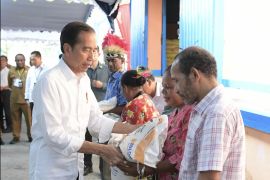"The forefront of Indonesia's maritime sovereignty is in Biak Numfor, so we must protect the potential of marine and fisheries resources to bring benefits to indigenous Papuans as well,” Head of Biak Numfor District, Herry Ario Naap, has said.
The Biak waters have become a source of the blue economy in the marine and fisheries sector nationally.
Naap stated that the catch of fishery products, especially yellowfin tuna, could reach 1.1 million tons per year, with an estimated potential income of Rp17 trillion annually.
The abundant maritime and fisheries economic potential did not only support non-tax state income but also becomes a source of strength in future for maintaining Indonesia's maritime sovereignty in the Pacific region.
Data from the Directorate General of Marine Resources and Fisheries Supervision at the Ministry of Maritime Affairs and Fisheries recorded that the economic potential of Padaido Islands amounted to Rp68.9 trillion and is included in the 10 highest economic values of national water conservation areas.
In future, the potential for marine and fisheries resources in Biak Numfor District will become a promising source of non-tax state revenue.
Naap also stated that sustainable management of maritime natural resources can improve the welfare of residents in the villages and coastal islands of Biak Numfor District.
By 2023, two tuna investors had started managing Biak's maritime wealth by exporting fresh tuna every week to Japan via the Frans Kaisiepo International Airport, Biak.
The Biak Fisheries Service stated that the total export of fresh tuna to Japan was around 150 tons.
The presence of investors in the region also opens new job opportunities for young residents at Biak Numfor.
In addition, Biak has historical tourist attractions from World War II, for instance, the Catalina Ship underwater museum, Owi Island Airport, Binsari Japanese Cave, and the World War II Monument.
Papua Province has been expanded into eight district governments and one city government. With its maritime wealth, the region has the opportunity to increase the community’s income and improve the welfare of its members.
The main potential of Papua Province is currently shifting, from mining to the marine and fisheries sector.
Chairman of the Steering Committee for the Acceleration of Papua's Special Autonomy Development, Pastor Albert Yoku, reminded that fisheries and maritime potential in Papua should be managed properly in a sustainable manner to improve the welfare of Papuans, including indigenous people.
With the issuance of Law Number 21 of 2021 concerning Special Autonomy for Papua, the vision and mission for Papua's development for the next two decades must be able to realize a Healthy Papua, Smart Papua, Productive Papua, and Peaceful Papua.
The Productive Papua Policy is related to the potential of maritime natural resources in each district and city to be utilized to improve the economy of indigenous Papuans. The policy also refers to indigenous Papuans residents to be able to be involved in managing marine and fisheries resources.
Moreover, Head of the Papua Maritime and Fisheries Service, Iman Djuniawal, admitted that the fisheries potential is a source of economic income for indigenous Papuans that live in coastal areas in Papua.
In 2023, the Ministry of Maritime Affairs and Fisheries regulated management policies in the fisheries sector by building the Samber-Binyeri Modern Fishermen Village (Kalamo) in Yendidori Sub-district, Biak Numfor District.
The modern fishermen village was equipped with various facilities for fishermen's needs, including a designated gas station for them.
The local community is also involved in the village’s management organization.
This concept is relatively new, as the indigenous Papuans is trusted to manage fisheries and marine potentials in the village. The involvement of local residents in the village management also opens new source of income for local fishing families.
One of the island regions in Papua Province, Biak Numfor District, has a total area of 15,124 square kilometers, with a land area of 2,602 square kilometers and a sea area of 12,522 square kilometers, comprising the Padaido/Aimando Islands and the Numfor Islands.
As an island region, Biak Numfor has abundant maritime natural resources, as it is located in the Pacific Ocean, northern Papua.
The Padaido Islands consist of small islands that are traditionally divided into two parts, namely the Upper Padaido Islands and Lower Padaido Islands.
Meanwhile, the Numfor Islands consist of five sub-district governments with 39 villages having fisheries potential of crabs, shrimp, and tuna. These three maritime commodities have high economic value.
Moreover, the Padaido/Aimando and Numfor Islands are dominated by water areas with rich fisheries and marine resources as a home for 200 marine biota belonging to 58 families.
The Biak water area is located on the edge of the Pacific Islands with marine resources, such as yellowfin tuna, mackerel, and various coral reefs.
The residents make use of these maritime resources through fishing to meet their daily needs.
The region also has abundant faunal resources, including 26 types of birds, 14 types of reptiles, seven types of mammals, and four types of insects.
In addition, the local people produce coconut oil through traditional processing from the fruit of coconut trees.
The Biak marine islands, which are rich in potential maritime natural resources, were designated as a Marine Tourism Park Area through Decree of the Minister of Environment and Forestry Number 91/Kpts-VI/97.
These maritime natural resources can attract investors to help the indigenous Papuans in managing their marine and fisheries potential to improve their welfare.
Maritime resources in Biak also act as a marine conservation area to protect it from environmental degradation, serve as a habitat for fishes, and to protect coral reefs and mangroves.
Related news: Biak Numfor receives five tons of rice reserves to deal with stunting
Related news: President Widodo provides food aid in Papua's Biak Numfor
Translator: Muhsidin, Resinta Sulistiyandari
Editor: Arie Novarina
Copyright © ANTARA 2023

